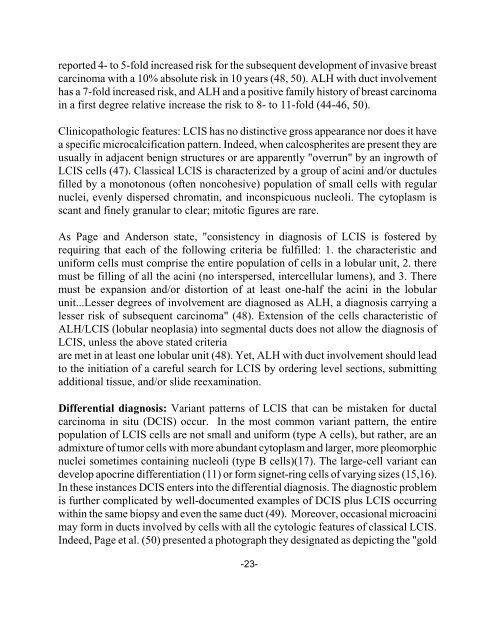33 Special Types of Invasive Breast Carcinoma: Diagnostic Criteria ...
33 Special Types of Invasive Breast Carcinoma: Diagnostic Criteria ...
33 Special Types of Invasive Breast Carcinoma: Diagnostic Criteria ...
Create successful ePaper yourself
Turn your PDF publications into a flip-book with our unique Google optimized e-Paper software.
eported 4- to 5-fold increased risk for the subsequent development <strong>of</strong> invasive breast<br />
carcinoma with a 10% absolute risk in 10 years (48, 50). ALH with duct involvement<br />
has a 7-fold increased risk, and ALH and a positive family history <strong>of</strong> breast carcinoma<br />
in a first degree relative increase the risk to 8- to 11-fold (44-46, 50).<br />
Clinicopathologic features: LCIS has no distinctive gross appearance nor does it have<br />
a specific microcalcification pattern. Indeed, when calcospherites are present they are<br />
usually in adjacent benign structures or are apparently "overrun" by an ingrowth <strong>of</strong><br />
LCIS cells (47). Classical LCIS is characterized by a group <strong>of</strong> acini and/or ductules<br />
filled by a monotonous (<strong>of</strong>ten noncohesive) population <strong>of</strong> small cells with regular<br />
nuclei, evenly dispersed chromatin, and inconspicuous nucleoli. The cytoplasm is<br />
scant and finely granular to clear; mitotic figures are rare.<br />
As Page and Anderson state, "consistency in diagnosis <strong>of</strong> LCIS is fostered by<br />
requiring that each <strong>of</strong> the following criteria be fulfilled: 1. the characteristic and<br />
uniform cells must comprise the entire population <strong>of</strong> cells in a lobular unit, 2. there<br />
must be filling <strong>of</strong> all the acini (no interspersed, intercellular lumens), and 3. There<br />
must be expansion and/or distortion <strong>of</strong> at least one-half the acini in the lobular<br />
unit...Lesser degrees <strong>of</strong> involvement are diagnosed as ALH, a diagnosis carrying a<br />
lesser risk <strong>of</strong> subsequent carcinoma" (48). Extension <strong>of</strong> the cells characteristic <strong>of</strong><br />
ALH/LCIS (lobular neoplasia) into segmental ducts does not allow the diagnosis <strong>of</strong><br />
LCIS, unless the above stated criteria<br />
are met in at least one lobular unit (48). Yet, ALH with duct involvement should lead<br />
to the initiation <strong>of</strong> a careful search for LCIS by ordering level sections, submitting<br />
additional tissue, and/or slide reexamination.<br />
Differential diagnosis: Variant patterns <strong>of</strong> LCIS that can be mistaken for ductal<br />
carcinoma in situ (DCIS) occur. In the most common variant pattern, the entire<br />
population <strong>of</strong> LCIS cells are not small and uniform (type A cells), but rather, are an<br />
admixture <strong>of</strong> tumor cells with more abundant cytoplasm and larger, more pleomorphic<br />
nuclei sometimes containing nucleoli (type B cells)(17). The large-cell variant can<br />
develop apocrine differentiation (11) or form signet-ring cells <strong>of</strong> varying sizes (15,16).<br />
In these instances DCIS enters into the differential diagnosis. The diagnostic problem<br />
is further complicated by well-documented examples <strong>of</strong> DCIS plus LCIS occurring<br />
within the same biopsy and even the same duct (49). Moreover, occasional microacini<br />
may form in ducts involved by cells with all the cytologic features <strong>of</strong> classical LCIS.<br />
Indeed, Page et al. (50) presented a photograph they designated as depicting the "gold<br />
-23-


